 (2.57 avg; 14 ratings) rate it
(2.57 avg; 14 ratings) rate it
Alexander Liebeskind’s Wall Street Journal crossword, “Between the Two of Us”—Jim’s review
Theme answers are familiar phrases that have had their letters I changed to letters U. The revealer is “IF I WERE YOU…” (58a, [Lead-in to a bit of advice, and a hint as to how 17-, 24-, 37- and 45-Across might arise]).
- 17a. [Pickup that’s a steal?] CHEAP TRUCK.
- 24a. [Big cat with a passion for the Ramones?] PUNK PANTHER. Or maybe the Pink Panther painted on someone’s mohawk?
- 37a. [Artisans who make decorative scarves?] BOA CONSTRUCTORS.
- 45a. [Source of music in the Amazon?] JUNGLE BELLS.
Nice. Fun phrases and no extraneous I’s left unchanged. I will say that the theme is employed rather loosely since there are so many potential theme answers left by the wayside (RAT FUNK, MOBY DUCK, PRUDE PARADE, etc.). But barring adding an additional constraint, as long as the entries we get are lively, fun, and have good surface sense, I’m relatively happy. There’s definitely something to be said for going for entertainment value over technical rigidity.
I had a brief thought that the title should be read as “Between the Two of U’s”, but there aren’t two U’s in any of the answers, so I think the phrase is just a synonym for the revealer.
Good long fill: Sonia SOTOMAYOR, SMELL A RAT, INDY CARS, and POLO BALL. And hardly a thing to scowl about either. Nice!
Clue of note: 11d. [Only planet not named after a deity]. EARTH. The word comes from the old English/German word for “the ground.” Yawn.
Good puzzle. 3.5 stars.
Bill Thompson’s New York Times crossword–Amy’s recap
The theme is three evil spells and one neutral one, plus four entries that “break” the spells in that the letters are at the beginning and end of those four entries.
HEX is in [First U.S. secretary of war] HENRY KNOX. Holy cats, we’re supposed to know this name before the Saturday puzzle? A CHARM is in CHICKEN PARM. CURSE is in a CRASH COURSE. A POX of the non-viral sort feels awfully antiquated and that word’s broken by PENCIL BOX clued as [Container in a kid’s backpack]; I’m not sure kids have actual pencil boxes in their backpack–when I was a kid, I had a pencil box in my desk at school and nobody had backpacks yet. Maybe a zip-up pencil case in the backpack? My sister works in an elementary school and reports that pencil boxes stay in the desks.
Fact check: Is the Times certain that Crayola brought out a HOT MAGENTA crayon in 1972? The Crayola fandom wiki says it was 1990. I was a Crayola user in 1972 and I sure as hell don’t have childhood memories of a hot magenta crayon.
Overall, I didn’t enjoy this puzzle. APPLE BETTY and HOT MAGENTA are longer than two of the Across theme entries. OLEATE, OAST, AD RATES, STET, HOBS, KING RAT, green-painty NPR TOTE, plural EMMAS, and ARMY clued in a way I needed all the crossings ([“Gee, I Wish I Was Back in the ___” (song from “White Christmas”)])? Not for me.
2.75 stars from me.
Rebecca Goldstein’s New Yorker crossword – Kyle’s write-up
More crossword intrigue from The New Yorker – it’s a themed puzzle on a Wednesday! I can’t recall seeing an announcement about a format change in the weekly lineup. It will be interesting to see comments from regular New Yorker solvers who will be expecting an easy themeless today.
So then: this puzzle is brought to us by Rebecca Goldstein. On the webpage there’s a blurb* that says “Today’s theme: Do you follow?”. The theme answers have something in common:
- 17A [Breed sent after a scent] BLOODHOUND
- 25A [Phone download for the health-conscious] FITNESS APP
- 36A [Piece of filming equipment that allows for a smooth moving shot] STEADICAM
- 49A [Structure for monitoring flights or weather] RADAR TOWER
The revealer is 59A [“Sounds about right”…or a description of 17-, 25-, 36- and 49-Across] “THAT TRACKS”. So a bloodhound tracks a scent, a fitness app tracks health, a steadicam tracks a scene (or maybe it’s an intransitive verb in this context), and a radar tower tracks flights or weather. I found it interesting to uncover the link and the theme entries are a nice collection in their own right.
Other highlights:
- I appreciate that Rebecca, a biomedical researcher, brings science into her puzzles. Here it’s [Gene therapy field] for BIOTECH and [Bacteria that can produce human insulin] for E. COLI.
- Bonus fun fill: PLOT SUMMARY, NOISEMAKERS, “BAD IDEA”, “I’M A MESS”, DEEP CUT.
- I liked the imperative clue on SCOOT: [“Make room on the couch”]
- HSA [Pre-tax funds for medical expenses: Abbr.] is rare as a three-letter entry in crosswords. The Cruciverb database shows only one other appearance, and that was in another puzzle by Rebecca Goldstein (with Rachel Fabi) that ran in the LA Times last year. A bit odd we don’t see this entry more often, no? given the ubiquity of medical insurance and medical expenses in American life. (Those initial stand for health savings account, if you didn’t know.)
Thanks Rebecca!
*Why don’t they just run a title with the puzzle?
Dylan Schiff’s AV Club Classic crossword, “Fetching Looks”—Amy’s recap
The name of the game is DOGGY STYLE, [Certain sex position … or a possible description of 17-, 21-, 39-, and 57-Across]. Those four themers are items of apparel whose names start with types of dogs. I have never, ever heard of POM BEANIES. Is that just knit hats with pom-poms on top? I miss the good old days when nobody called a hat made of yarn a “beanie.” The dog is a Pomeranian. POODLE SKIRT doesn’t mesh great with the other three because that skirt often had a poodle dog appliqued onto it, vs. some other non-dog sense of the word as in the other three themers. There’s a LAB COAT, no relation to a Labrador retriever, and BOXER BRIEFS, connected to boxer shorts and boxing rather than the dog called a boxer.
Fave fill: POP-TOP CAN, SHOE PHONE, YAMMERS ON, BACKRUB, and ROSE ROYCE, working at the car wash.
3.5 stars from me. Liked it overall, but the POODLE SKIRT’s deviation from the other themers’ norm distracts me.
Trent H. Evans’s LA Times crossword – Gareth’s summary
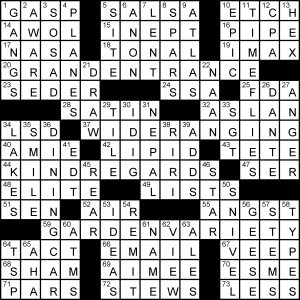
LA Times
240410
Sigh. I feel like the theme type in today’s puzzle by Trent H. Evans is a little over-exposed. GARDENVARIETY = “anagram” garden, then find it between two parts of long across answers. I kind of miss the days when this revealer would mean each answer’s first word fit the pattern “___ GARDEN”:
- [*Splashy arrival], {GRANDE}NTRANCE
- [*Like a conversation covering many topics], WI{DERANG}ING
- [*Friendly signoff], KI{NDREGA}RDS
The puzzle itself had a Monday/Tuesday layout with smaller stacks – it fell rather easy for a Wednesday, but the distinctions can be a tad arbitrary.
There were some playful clues though:
- [Webb designer?], NASA
- [Org. that says no to some drugs], FDA
- [Place to eat while on the go], DININGCAR
Kind Regards
Gareth
Shannon Rapp & Will Eisenberg’s USA Today Crossword, “Ladybird” — Emily’s write-up
Feeling some late night inspiration while writing up of this awesome puzzle–girl power!
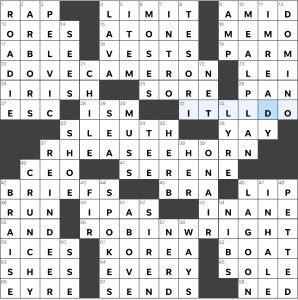
USA Today, April 10, 2024, “Ladybird” by Shannon Rapp & Will Eisenberg
Theme: each themer begins with a type of bird
Themers:
- 20a. [She played both lead roles on “Liv & Maddie”], DOVECAMERON
- 37a. [She played Kim Wexler in “Better Call Saul”], RHEASEEHORN
- 56a. [She played Claire Underwood in “House of Cards”], ROBINWRIGHT
In addition to the theme, the entire set is female as well which is hinted at by the title as well. The set of actors includes DOVECAMERON, RHEASEEHORN, and ROBINWRIGHT. Even if any were new to solvers, the crossings were fair and easy enough to fill.
Favorite fill: MEALPLAN, SLEUTH, MOSES, and SHES
Stumpers: TENSORI (new to me), LIMIT (kept thinking “lid” something), and INANE (needed some crossings)
Love the grid and it was a smooth solve overall, except for the northern section; TENSORI, INTRO, and ITEM crossing with an actor new to me meant that was the last are that I filled in and it was tricker than it might have been for others. So fun to see many other women and female references included in entries or clues too, plus HER and BRA crossing. Nice!
4.25 stars
~Emily

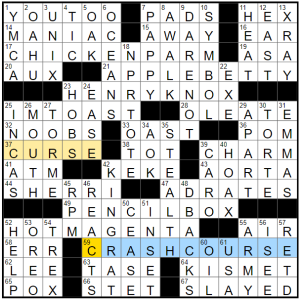
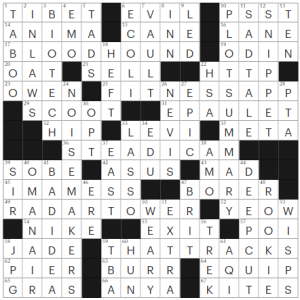
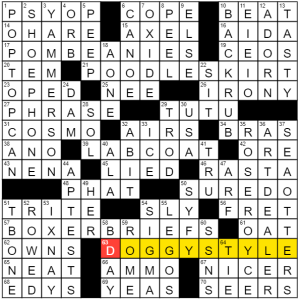
Crayolagate.
According to Wikipedia hot magenta Crayola was introduced in 1972 and renamed razzle dazzle rose in 1990. This seems to be the source of the confusion at the Crayola wiki.
The Belgian Crayola site also confirms the 1972 date. (I would link it, but multiple links always cause my posts problems here.) Oddly, the US Crayola site is silent on the introduction date of obsolete names.
Maybe it was a color in Belgium but not in the US. My sister also does not recall any hot magenta Crayola color in the 1970s!
Your Crayola fandom wiki explains that the 1972 hot magenta was renamed in 1990 and a new version of hot magenta was released then.
I was always SO jealous of my classmates with the 64-crayon box with the the built-in crayon sharpener. Our budget limited me to 16. So I would never have known about it, even though by 1972 I was already in college.
Took me quite a bit longer than the average Wednesday.
Wow. Amy is pretty nasty today.
I thought her scrutiny was fair and not mean-spirited in any way. I enjoy reading the recaps each day and don’t think “nasty” is ever a nice way to describe the work that these folks do.
I also don’t think Amy was being nasty, as opposed to pretty blunt that she didn’t care particularly for the puzzle. She gave very clear reasons why it was not one of her favorites.
While I haven’t begun it, I see that today’s TNY is themed rather than “beginner’s.” That could annoy someone wanting predictability, but maybe it just means that, rather than reverting to the previous 3-day scheme, they’re trying to accommodate fans of the 5-day scheme in 3 days by varying things from week to week. Maybe it’ll turn out less boring than an easy puzzle, too, but we’ll see.
That said, I’d hate to complain about Monday’s theme, so I wouldn’t look there for more of a pattern. While I know that crossword purists here may just plain hate themes, there’s no reason on principle that a themed puzzle couldn’t be hard as befits a Monday, although that one wasn’t. (Themed cryptics are the hardest puzzles out there, like the old Atlantic puzzles from Hex.) More important, I’ll happily accept that Sunday and Monday puzzles everywhere just could not get enough of the eclipse, so it was inevitable. (Also maybe the best of whole lot.)
Well, to answer my own question, it was very easy. (Does bend over backward for contemporary usage, but fine.)
Oh, “Why don’t they just run a title with the puzzle?” You said it was on the Web page, but it’s also in the pdf. Did it not make it into puz? May just be that online solvers are supposed to use the Web page, and Crossword Scraper can do only so much.
I was also wondering about Kyle’s comment. FWIW, the title was in the PUZ file that I got out of CrosswordScraper.
I’ve never met or heard of any crossword “purist” (whatever that means) who hates themes.
I don’t hate themes, but I definitely prefer themeless. The themes I appreciate the most are the knock-your-socks-off ones that we see a few times a year.
I suspect the New Yorker had already accepted some themed puzzles and then management made the cutbacks decision. Running themed puzzles in two of three 15×15 slots this week means that only one of the New Yorker’s robust stable of themeless constructors gets paid this week, vs. the previous usual of four themeless paychecks a week.
That makes sense — a backlog.
This NYT felt harder than it needed to be. Plenty of glue entries aside, some of the clueing was suspect. Why are we clueing ASA as some guy who died in 1950’s real name? Gotta be something better than that. SHERRI crossing TORME and KINGRAT was a bit tricky as well.
Al Jolson was a big deal in his day and is remembered (probably not correctly) as the first movie actor to star in what was then called a “talkie.”
I had no idea what his first name was, and there are certainly easier ways to clue ASA.
On the whole, I found the NYT puzzle a bit more challenging than the average NYT Wednesday, which is fine with me.
This puzzle felt like an odd combination of clues and answers that are harder-than-usual for a Wednesday (OLEATE??) crossed by a lot of easy stuff. It seemed kinda hard on my first pass – I felt like was just not on the constructor’s wavelength – and then quickly came together on the second pass. In the end I finished about 20% faster than average.
I did think POX was kind of an outlier, being that it denotes a disease, and is only metaphorically a curse. I hesitated there for a beat, until the crosses confirmed it.
I haven’t kept up with Crayola colors through the years, but I was a white child in a northern multi-racial elementary school pre-1962, when “Flesh” was famously changed to “Peach.” I recall thinking that “Flesh” was a weird name for that color, because (1) there are so many different colors of flesh, and (2) nobody I knew had a skin tone the color of that crayon.
Some strange entries for sure. Can’t say I was stopped by TORME, who’s a crossword fixture (and I vaguely do remember him, but that’s neither here nor there), or by the color crayon, since I was going to accept whatever they had on faith, not remembering my early childhood crayon box. But others mentioned are out there.
I actually went down a rabbit hole at first, since I knew of only APPLE brown BETTY and wondered if the theme were going to need deletions of displacements.
TNY: Enjoyed this one, it wasn’t a simple one as I was expecting (seems like last Wed. was ‘beginner level’, no?) I learned that Ecoli can make insulin which I did not know, and also didn’t know the origin of the Sobe brand name.
The theme was very reasonable as well. I agree with JohnH above that Monday’s TNY eclipse-theme was the best of all the same-themed puzzles, and it didn’t disappoint (after my original upset at it not being a “challenging” puzzle… it was challenging enough to be enjoyable, and the theme well-worked.)
I love crossword rabbit holes. Amy’s great Crayola fandom wiki has been a fun one. To close the loop on why Amy and her sister missed this color, we have the story of “neon” Crayola colors, known at their 1972 introduction as fluorescent colors.
These first eight fluorescent crayons (and yes, hot magenta was one) were not included in any of the standard boxes, even my holy grail 64-pack. They were distributed in a separate fluorescent color box. Weirdly, they were wrapped in black paper sleeves, not matching colored paper.
The following year, a 72!-color box was released, with the 8 fluorescent colors added to the 64. I never saw this treasured packaging, and suspect the same was true for many others.
Only in 2019 did fluorescent give way to “neon,” when pearlescent colors were added to the older fluorescent colors (plus some metallics) to make the modern complement. And we also learned that the fluorescent colors are really phosphorescent, via some patent applications.
I really missed the Golden Age of Crayons.
I can’t help thinking that the 1972 fluorescents must have had limited distribution, because my sister and I would surely have begged our mom to buy them if they were in the school supplies aisle at the store.
Really enjoyed WSJ today.
Ditto that! It was great fun, thanks in part to the image it left me with: a punkish boa-wearing panther named April jamming to some Cheap Trick in the jungle.